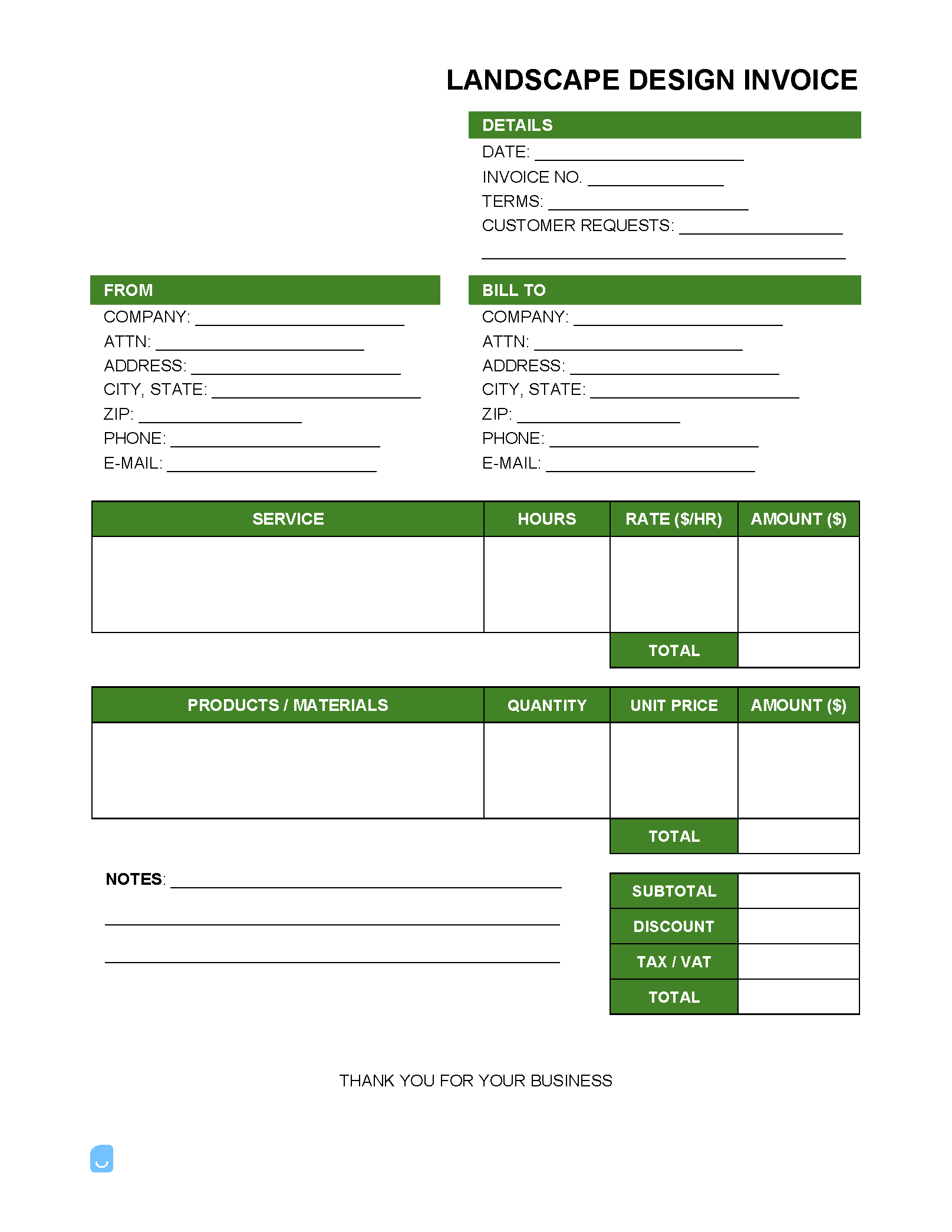How to Create a Landscape Design Invoice
A landscape design invoice is a document that is used to request payment for services rendered by a landscape designer. The invoice should be sent to the client within a reasonable time frame after the services have been rendered. If the invoice is for a large project, the payment method may be broken down into phases, with each phase having its own due date. For example, a common method is to require a deposit upon signing of the contract, with the remaining balance due upon completion of the project. The cost of the landscape design invoice will also depend on the experience of the landscape designer and the complexity of the project.
What is a Landscape Designer?
Through the use of scaled digital or paper drawings, in-depth analysis of the client’s current lawn, soil, and plant composition, and specialized skills learned through formal or informal education, landscape designers can transform the look and feel of outdoor spaces significantly. The art of landscape design entails planning and execution. It requires the skill of taking a mental design of a landscape and putting it on paper and bringing that design to life by planting trees, grass, shrubs, flowers, and plants, moving earth, installing fixtures, and so on. This work can include arranging the installation of mulch, stone, pavers, lighting, irrigation, drainage, and other features. Landscape designers can work on their own as freelancers or contractors or for private or government-run organizations. Their time is typically divided between indoors and outdoors on job sites, with more or less time dedicated to one or the other depending on the employer.
How to Become a Certified Landscape Designer
To become a certified, professional landscape designer or landscape architect, you’ll need a plan, an internship, and certification through an approved agency. Here are some suggestions for the aspiring landscape designer:
Step 1 – High School Degree or GED
 Earning a diploma or GED is an essential step for every type of landscape designer, even if university study will be pursued or not.
Earning a diploma or GED is an essential step for every type of landscape designer, even if university study will be pursued or not.
Step 2 – Formal Education
 To earn the title of a landscape architect, the student will have to earn at minimum a bachelor’s degree, and in some cases, a master’s degree. Technically, landscape designers do not need formal education beyond high school, although obtaining said education can boost their career prospects significantly. For a complete list of ASLA (American Society of Landscape Architects) approved schools, check out the ASLA’s Degree Programs by State.
To earn the title of a landscape architect, the student will have to earn at minimum a bachelor’s degree, and in some cases, a master’s degree. Technically, landscape designers do not need formal education beyond high school, although obtaining said education can boost their career prospects significantly. For a complete list of ASLA (American Society of Landscape Architects) approved schools, check out the ASLA’s Degree Programs by State.
Step 3 – Internship / Job
 Obtaining experience and building a portfolio is essential for earning certification in either design or architecture. For aspiring landscape designers who did and didn’t go through formal education after high school, obtaining experience through an internship is vital. Both paid and unpaid internships can be found during or after graduation and give candidates the necessary portfolio work to become certified or licensed.
Obtaining experience and building a portfolio is essential for earning certification in either design or architecture. For aspiring landscape designers who did and didn’t go through formal education after high school, obtaining experience through an internship is vital. Both paid and unpaid internships can be found during or after graduation and give candidates the necessary portfolio work to become certified or licensed.
Step 4 – Certification
 Landscape designers and landscape architects have separate means of licensing. Below are the two (2) major licensing organizations for both professions:
Landscape designers and landscape architects have separate means of licensing. Below are the two (2) major licensing organizations for both professions:
- American Society of Landscape Architects (ASLA) – Licenses are issued at the state level for university-educated landscaping architects. Check out the ASLA’s fifty (50) state guide for each state’s examination and licensing requirements.
- Association of Professional Landscape Designers (APLD) – To earn the APLD Certification, candidates have to have worked as landscaping designer’s for a minimum of three (3) years, submit three (3) installed projects, and pay a $200 application fee. For those preparing to apply for certification, the APLD Criteria for Certification document contains a complete breakdown of what aspiring applicants need to do to prepare successfully.
Landscape Designer/Architect Salary & Hourly Rate ($/hr)
According to the United States Bureau of Labor Statistics, the average landscape architect earns the following: Salary: $74,980/yr Hourly rate: $36.05/hr
What Do Landscape Designers Actually Do?
Landscape designers have to, first and foremost, consider the climate in the client’s area. They choose plants that are native to that area or that are known to do well in that climate. This will help ensure that the plants are healthy and will thrive in the given landscape. The second thing they consider is the amount of sun and shade in the landscape. They’ll typically decide on a focal point for a landscape. This could be a beautiful tree, a fountain, a piece of art, or anything else that would make a stunning centerpiece for a yard. Then they’ll plan the rest of the landscaping around it. They’ll use color to create a mood and incorporate such features as plants, trees, shrubs, flowers, walkways, patios, water features, and more to create a pleasant space. The goals of landscape design include improving the aesthetic appeal of a space, creating a more functional outdoor living area, increasing the value of a property, and providing environmental benefits.
Hardscape vs. Softscape
Often landscape designers will use the terms “hardscape” and “softscape.” The difference is simple. Hardscape refers to features that are “hard” and non-living, such as pavers, stone, bricks, concrete, and even lighting. Hardscape would include, for example, a walkway or a pergola. Softscape, on the other hand, refers to the “soft” things in the garden, such as soil, shrubs, flowers, and trees. Often the softscape is described as containing living things, but this is not always the case; artificial grass or turf, for example, would also be considered part of the softscape.
How to Quote a Landscape Design Job
In order to come up with a proposal for a landscaping job and a reasonable cost estimate, consider the following:
- Features required
- Plants and materials required
- Whether the location is remote
- Whether you’ll need subcontractors, who, and how many
- Your subcontractors’ labor costs
- Your hourly rate
- Your markup
- Tax
Landscaping Network has a list of price estimates for specific jobs, which can be accessed here.
What to Include in a Landscape Design Invoice
The purpose of the landscape design invoice is to provide a detailed account of the work that was performed, the materials that were used, and the cost of the services rendered. Here’s a list of elements to include on the invoice:
- Name and contact information (e.g. address and phone number) for landscaping business
- Logo for business if applicable
- Name and contact information (e.g. address and phone number) for customer
- Description of the services rendered
- Price of those services
- Applicable taxes
- Payment methods (e.g. check, money order, credit card, or PayPal)
- Payment instructions
A landscaping invoice template can be generated manually using a program like Microsoft Excel or via an online invoicing generator like Invoice Maker.
